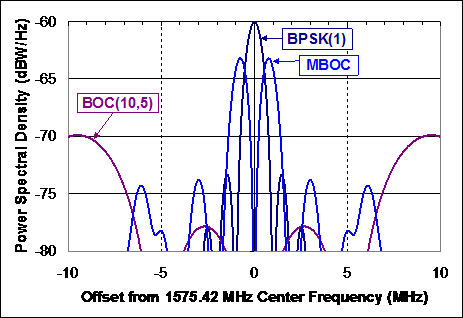
L1C Another Civil Signal
Another civil signal is broadcast by the Block III satellites. It is known as L1C. As a result of an agreement between the United States and the European Union (EU) reached in June 2004, this signal will be broadcast by both GPS and Galileo’s L1 Open Service signals. It will also be broadcast by the Japanese Quasi-Zenith Satellite System (QZSS), the Indian Regional Navigation Satellite System (IRNSS), and China's BeiDou system. These developments open extraordinary possibilities of improved accuracy and efficiency when one considers there may eventually be a combined constellation of 50 or more satellites, all broadcasting this same civilian signal. All this is made possible by the fact that each of these different satellite systems utilizes carrier frequencies centered on the L1, 1575.42 MHz. Perhaps that has something to do with the fact that L1, having the highest frequency, experiences the least ionospheric delay of the carrier frequencies. There are many signals on L1, but looking at GPS alone, there is the C/A code, the P(Y) code, the M code and now L1C code. It is a challenge to introduce yet another code on the crowded L1 frequency and still maintain separability.
As shown in the figure above, the L1C design shares some of the M code characteristics, i.e., Binary Offset Carrier. It has some similarities with L2C. For example, it has a data-less pilot signal (L1CP) and a signal with a data message (L1CD) whose codes are of the same length as CM on L2C 10,230 chips and broadcast at 1.023 Mbps. The data signal uses BOC (1, 1) modulation, and the pilot uses time multiplexed binary offset carrier (TMBOC). The TMBOC is BOC (1, 1) for 29 of its 33 cycles, but switches to BOC (6, 1) for 4 of them. The pilot component has 75% of the signal power, and the data portion of the signal has 25%. This means that L1C has good separation from the other signals on L1, a good tracking threshold, and a receiver reaches its first fix to the satellite broadcasting L1C faster. The utility of L1C is further enhanced by the fact that it has double, 1.5dB, the power of C/A.
The message carried by L1CD is known as CNAV-2. Unlike CNAV, CNAV-2 has frames. Each frame is divided into three sub-frames. Both CNAV and CNAV-2 have 18% more satellite ephemeris information than NAV. The structure of CNAV-2 virtually ensures that once a receiver acquires the satellite, the time to first fix will not exceed 18 seconds.
L1C will likely be operational in a few years. However, it will not be fully operational until it is broadcast by 24 satellites